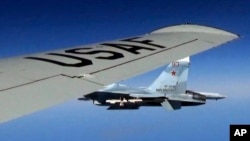The Russian Defense Ministry claimed that the Su-27’s encounter with the U.S. ЕР-3Е Aries II in international airspace over the Black Sea on January 29 was “no incident” but a routine operation. According to the ministry, the Russian fighter jet approached at a “safe distance” and the flight “was performed in strict compliance with international rule[s] of airspace use.”
According to independent experts, none of these statements is true or accurate.
U.S. State Department spokesperson Heather Nauert said, in a written statement, The Russian fighter jet closed “to within five feet and crossing directly in front of” the U.S. aircraft.
The European Leadership Network [ELN] a London-based policy group focusing on defense and security issues, monitors encounters between the armed forces of NATO and its partners, on the one hand, and the Russian Federation, on the other, since March 2014.
According to the ELN report “Russia – West Dangerous Brinkmanship,” 66 incidents identifiable from public sources took place between March 2014 and March 2015.
The Dangerous Brinkmanship report details three “high risk,” 13 “serious” and 50 “near-routine” incidents during that period.
The author of the ELN report, British security expert Thomas Frear, @FrearUK disagrees with the Russian Defense Ministry’s categorization of the January 29 incident over the Black Sea.
Frear told Polygraph.info the encounter was “serious” and the Russian aircraft behaved “aggressively” and “outside of routine.”
“I would classify this incident as ‘Serious’ under the criteria developed for the Brinkmanship report, as it is an aggressive action outside of routine behavior, but based on currently available information did not pose a high risk of escalation,” Frear said in an email to Polygraph.info.
The Brinkmanship Report provides the following criteria for the “Serious” category: “Serious incidents go beyond the previously established pattern of interaction and involve close encounters of a more aggressive and unusually provocative nature.”
Frear’s assessment accords with those of the Pentagon and the State Department.
"This interaction was determined to be unsafe due to the Su-27 closing to within five feet and crossing directly through the EP-3’s flight path, causing the EP-3 to fly through the Su-27’s jet wash. The duration of the intercept lasted two hours and 40 minutes," the U.S. Naval Forces 6th Fleet Commander said in a statement.
“The Russian side was flagrantly violating existing agreements and international law, in this case the 1972 Agreement for the Prevention of Incidents On and Over the High Seas (INCSEA),” said Nauert, the State Department spokesperson. "The United States notes with the highest level of concern the latest incident of unsafe Russian military practices.”
U.S. Naval Forces Europe called the incident “an unsafe interaction with a U.S. EP-3 in international airspace.”
Nauert said this was just “the latest example of Russian military activities disregarding international norms and agreements.” She added: “We call on Russia to cease these unsafe actions that increase the risk of miscalculation, danger to aircrew on both sides, and midair collisions.”
TASS reported the Russian Defense Ministry said the Russian jet followed the U.S. aircraft to “prevent it from violating Russia’s airspace borders…”
However, the U.S. Naval Forces 6th Fleet Commander said, "The U.S. aircraft was operating in accordance with international law and did not provoke this Russian activity."
The Pentagon repeated the assertion and pointed to the protocols the U.S. Navy strictly follows: Office of the Chief of the Naval Operations’ Instruction 5711.96C, which prohibits American personnel from engaging in any acts that could create a potentially dangerous incident, including harassment and aggressive behavior.
